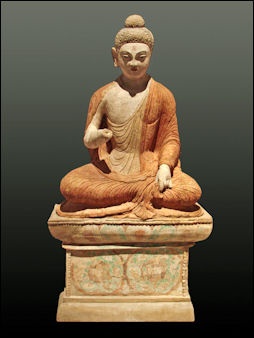The donative dedication of the sculpture can be seen in inscribed characters in the lower. Two lions sit astride an incense burner.
Period Of The Northern And Southern Dynasties 386 581 Essay The Metropolitan Museum Of Art Heilbrunn Timeline Of Art History
In the 1st century AD the earliest Buddhist sculpture emerged in Gandhāra a region in the northwest of ancient India showing Greco-Roman influence.
. Due to this the Buddhist art of China grew-up as a form of naturalism and realistic art that was flaunting the expression of Tang Buddhist art. -Wearing Chinese style dress which shows the changes in court from the move of the capital south. Tightly curled hair covering a cranial mound symbolizes his enlightenment.
Ch 16 Intertwining dragons Ch 16. Originally Buddhist art in Korea imitated Chinese This is a Korean style showing slender body elliptical face elegant drapery folds and trilobed crown This is an example of a gilt-bronze image of a bodhisattva seated in meditation pose is derived from Chinese. This artwork is dated 687 during the Tang dynasty 618906 and depicts the future Buddha Maitreya in a niche flanked by two monks and two bodhisattvas.
Which of the following best describes the sculpture of the Buddha in this image. The flattened elongated bodies of the Longmen bodhisattvas image left are hidden under elaborately pleated and flaring skirts. Lasting for less than 40 years this Suis brief unification of China produced a new sculptural synthesis a majestic style of restrained elegance and controlled sensuality lots 3508 3509 3510 and 3511 which formed the basis of Tang dynasty Buddhist sculpture.
These linear and abstract motifs are typical of the mature Northern Wei style as also seen in this gilt bronze statue of Buddhas Shakyamuni and Prabhutaratna from 518 CE. Which artist is a painter of the Tang Dynasty the golden age of Chinese figural painting. Figural representations of the Buddha in South Asia art The temple at Borobudur in Indonesia is designed to represent __________.
54a with description on p. There were cultural reforms to make the Northern Wei court in the style of the Chinese court which was known for bureaucracy because of confucianism. A Study Based on Bronze and Stone Statues other than Works from Cave-Temples Tokyo 1966 pl.
Seated with the legs pendent over the seat an ushnisha over a crisply cast hairline and facial features the wide almond shaped eyes and aquiline nose above fleshy full lips the round face framed by pendulous ears the body with a simple monks robe covering both shoulders and partially exposing the chest concentric pleats falling below to. Li Cheng and Fan Kuan. Compare also the Northern Wei stone carving of a seated Buddha with very similar treatment of the drapery of the robes illustrated by Matsubara Chūgoku bukkyō chōkokushi kenkyū Chinese Buddhist Sculpture.
One source was the sculpture of the Northern Wei dynasty 386534 AD characterized by the frontal stance of the figures the flaring edges of their garments and the flamelike decoration on the halos. The Tang dynasty with its capital at Changan the most populous city in the world at the time is regarded by historians as a high point in Chinese civilizationequal or even superior to the. By the Sui and Tang periods the Pure Land Sect had gained ground and a much larger proportion of donative inscription was dedicated to Amitabha.
The early sculptures of the three kingdoms adapted the iconography and styles of those produced in the northern and southern regions of China. Maitreya dominate in the sixth century. Early form of Buddhist art was purposed to express the enlightenment ideals in a realistic manner.
Here artistic styles suggest connections with Central Asia and India and images of Shakyamuni and the future Buddha. This is seen in the chinese dress and filial piety of the buddha sculpture. The Sui dynasty ended Chinas two centuries of disunification and reopened the Silk Road leading to a rapid renaissance of Buddhism.
Tang dynasty art is Chinese art made during the Tang dynasty. It is a classic example of Chinas Buddhist stone carving from the period that saw perhaps the greatest flowering of Chinas plastic arts. And a forehead depression that originally held a stone or jewel represents wisdom.
After Buddhism spread to China around the 1st century AD Buddhist sculpture incorporated traditional Chinese elements gradually resulting in a unique Chinese style. The themes materials and. The Shakyamuni Buddha from the Kushan periods Gandahara style is remarkable for representing the earliest _____.
Which two painters are most similar in subject matter and style. Buddhist sculpture under the Tang dynasty was more graceful than its early form. Characteristic of Tang style in its robust tapered physique this monumental figure exhibits iconographic features distinctive to the Buddha.
Projects of this magnitude required hiring many sculptors working in the same style Ch 13. Which artist is a painter of the Tang Dynasty the golden age of Chinese figural painting. An Exceptional Tang Bodhisattva Regina Krahl This figure of a bodhisattva is remarkable for its graceful pose naturalistic yet genderless physique elegant flowing skirt and scarves and voluminous flower-decorated hair style.
Seven Buddhas of the past frame the central niche. During the Sui-Tang period 581-907 Buddhist sculptures reached an unprecedented height of sophistication and developed styles that perfectly reflected Chinese aesthetics. The period saw great achievements in many formspainting sculpture calligraphy music dance and literature.
Which phrase best describes the land of China in the eighth century under the Tang dynasty. The Tang sculptures here include six representations of Avalokiteshvara known.
Life Of The Buddha Essay The Metropolitan Museum Of Art Heilbrunn Timeline Of Art History

Buddhist Art In China Paintings Sculptures And Sutra Masterpieces Facts And Details

0 Comments